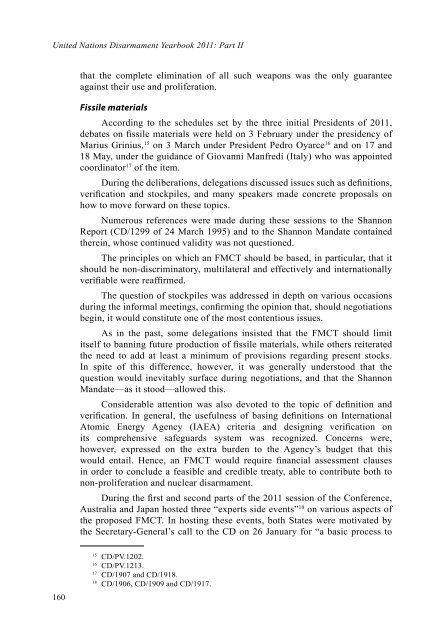DYB2011-Part-II-web
DYB2011-Part-II-web
DYB2011-Part-II-web
Create successful ePaper yourself
Turn your PDF publications into a flip-book with our unique Google optimized e-Paper software.
United Nations Disarmament Yearbook 2011: <strong>Part</strong> <strong>II</strong><br />
160<br />
that the complete elimination of all such weapons was the only guarantee<br />
against their use and proliferation.<br />
Fissile materials<br />
According to the schedules set by the three initial Presidents of 2011,<br />
debates on fissile materials were held on 3 February under the presidency of<br />
Marius Grinius, 15 on 3 March under President Pedro Oyarce16 and on 17 and<br />
18 May, under the guidance of Giovanni Manfredi (Italy) who was appointed<br />
coordinator17 of the item.<br />
During the deliberations, delegations discussed issues such as definitions,<br />
verification and stockpiles, and many speakers made concrete proposals on<br />
how to move forward on these topics.<br />
Numerous references were made during these sessions to the Shannon<br />
Report (CD/1299 of 24 March 1995) and to the Shannon Mandate contained<br />
therein, whose continued validity was not questioned.<br />
The principles on which an FMCT should be based, in particular, that it<br />
should be non-discriminatory, multilateral and effectively and internationally<br />
verifiable were reaffirmed.<br />
The question of stockpiles was addressed in depth on various occasions<br />
during the informal meetings, confirming the opinion that, should negotiations<br />
begin, it would constitute one of the most contentious issues.<br />
As in the past, some delegations insisted that the FMCT should limit<br />
itself to banning future production of fissile materials, while others reiterated<br />
the need to add at least a minimum of provisions regarding present stocks.<br />
In spite of this difference, however, it was generally understood that the<br />
question would inevitably surface during negotiations, and that the Shannon<br />
Mandate—as it stood—allowed this.<br />
Considerable attention was also devoted to the topic of definition and<br />
verification. In general, the usefulness of basing definitions on International<br />
Atomic Energy Agency (IAEA) criteria and designing verification on<br />
its comprehensive safeguards system was recognized. Concerns were,<br />
however, expressed on the extra burden to the Agency’s budget that this<br />
would entail. Hence, an FMCT would require financial assessment clauses<br />
in order to conclude a feasible and credible treaty, able to contribute both to<br />
non-proliferation and nuclear disarmament.<br />
During the first and second parts of the 2011 session of the Conference,<br />
Australia and Japan hosted three “experts side events” 18 on various aspects of<br />
the proposed FMCT. In hosting these events, both States were motivated by<br />
the Secretary-General’s call to the CD on 26 January for “a basic process to<br />
15 CD/PV.1202.<br />
16 CD/PV.1213.<br />
17 CD/1907 and CD/1918.<br />
18 CD/1906, CD/1909 and CD/1917.


